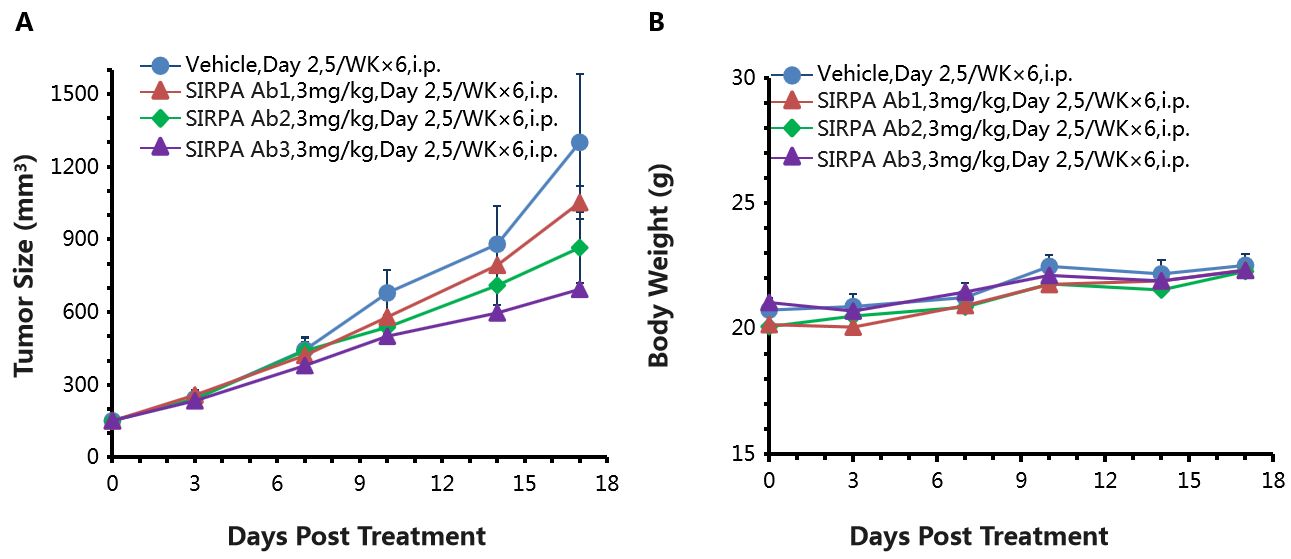


C57BL/6-Sirpatm1(SIRPA)Bcgen Cd47tm1(CD47)Bcgen/Bcgen • 120525
| Product name | B-hSIRPA/hCD47 mice |
|---|---|
| Catalog number | 120525 |
| Strain name | C57BL/6-Sirpatm1(SIRPA)Bcgen Cd47tm1(CD47)Bcgen/Bcgen |
| Strain background | C57BL/6 |
Gene targeting strategy for B-hSIRPA/hCD47 mice. The exon 2 of mouse Cd47 gene that encodes the IgV domain was replaced by exon 2 of human CD47 gene.
The exon 2 of mouse Sirpa gene that encodes the IgV domain was replaced by exon 2 of human SIRPA gene in the B-hSIRPA/hCD47 mice.
This double knock-in model was developed by mating the B-hSIRPA mice and the B-hCD47 mice together.
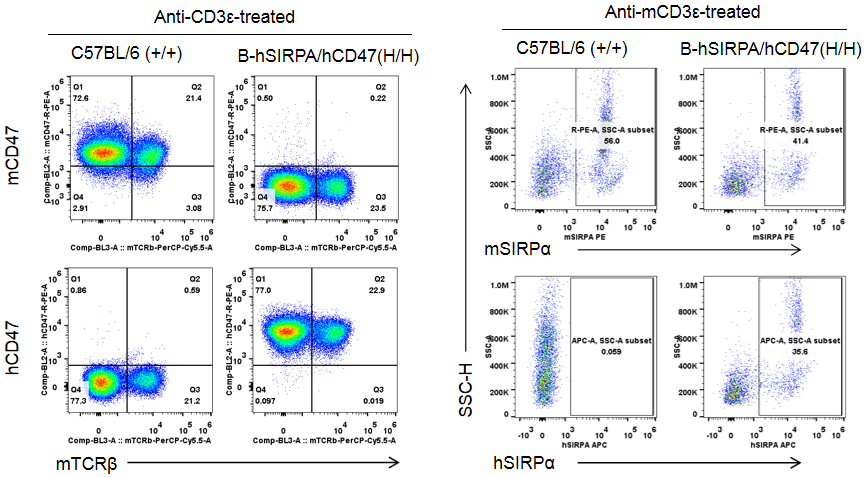
Strain specific CD47 and SIRPα expression analysis in homozygous B-hSIRPA/hCD47 mice by flow cytometry. Splenocytes were collected from wild type C57BL/6 mice (+/+) and homozygous B-hSIRPA/hCD47 mice (H/H) stimulated with anti-CD3ε in vivo, and analyzed by flow cytometry with species-specific anti-CD47 and anti-SIRPα antibodies. Mouse CD47 was exclusively detectable in wild type C57BL/6 mice. Mouse SIRPα was detectable in wild type C57BL/6 mice. This anti-mouse SIRPα antibody also reacts crossly with human SIRPα. Human CD47 and SIRPα were exclusively detectable in homozygous B-hSIRPA/hCD47 mice but not in wild type C57BL/6 mice.
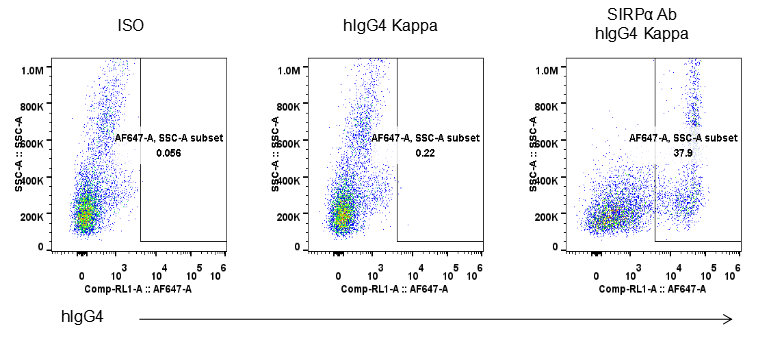
Analysis of peritoneal lymphocytes of B-hSIRPA/hCD47 mice by flow cytometry. Peritoneal lymphocytes were isolated from female B-hSIRPA/hCD47 mice (n=2, 8-week-old). Flow cytometry analysis of the peritoneal lymphocytes was performed to assess the expression of human SIRPα. Single live cells were gated for the CD45 population and used for further analysis as indicated here. Human SIRPα was detectable on the peritoneal lymphocytes of B-hSIRPA/hCD47 mice, as evidenced by anti-human SIRPα antibody binding vs. isotype control.

Analysis of spleen leukocyte subpopulations by FACS. Splenocytes were isolated from female C57BL/6 and B-hSIRPA/hCD47 mice (n=3, 6-week-old). Flow cytometry analysis of the splenocytes was performed to assess leukocyte subpopulations. A. Representative FACS plots. Single live cells were gated for the CD45 population and used for further analysis as indicated here. B. Results of FACS analysis. The percentage of T cells, B cells, NK cells, monocytes, DCs, granulocytes, and macrophages in homozygous B-hSIRPA/hCD47 mice were similar to those in the C57BL/6 mice, demonstrating that the introduction of hSIRPα and hCD47 in place of their mouse counterparts does not change the overall development, differentiation, or distribution of these cell types in the spleen. Values are expressed as mean ± SEM.
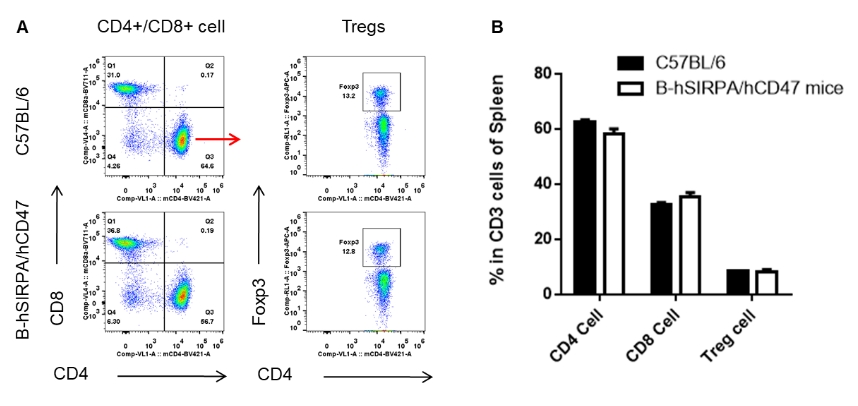
Analysis of spleen T cell subpopulations by FACS. Splenocytes were isolated from female C57BL/6 and B-hSIRPA/hCD47 mice (n=3, 6-week-old). Flow cytometry analysis of the splenocytes was performed to assess leukocyte subpopulations. A. Representative FACS plots. Single live CD45+ cells were gated for CD3+ T cell population and used for further analysis as indicated here. B. Results of FACS analysis. Percent of CD8+, CD4+, and Tregs in homozygous B-hSIRPA/hCD47 mice were similar to those in the C57BL/6 mice, demonstrating that introduction of hSIRPα and hCD47 in place of their mouse counterparts does not change the overall development, differentiation or distribution of these T cell subtypes in spleen. Values are expressed as mean ± SEM.

Complete blood count (CBC). Blood from female C57BL/6 and B-hSIRPA/hCD47 mice (n=3, 6-week-old) was collected and analyzed by CBC. There was no differences among any measurement between C57BL/6 mice and B-hSIRPA/hCD47 mice, indicating that introduction of hSIRPα and hCD47 in place of their mouse counterparts does not change blood cell composition and morphology. Values are expressed as mean ± SEM.
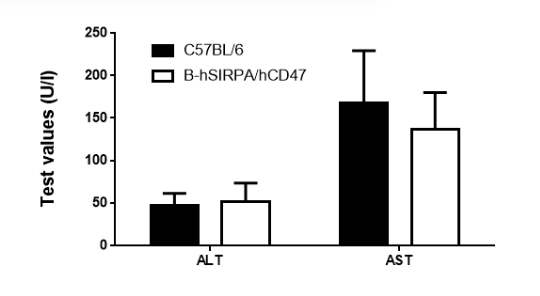
Biochemistry test of B-hSIRPA/hCD47 mice. Plasma from the C57BL/6 and B-hSIRPA/hCD47 mice (n=3, 6 week-old) was collected and analyzed for levels of ALT and AST. There was no differences on either measurement between C57BL/6 and B-hSIRPA/hCD47 mice, indicating that introduction of hSIRPα and hCD47 in place of their mouse counterparts does not change ALT and AST levels or health of liver. Values are expressed as mean ± SEM.
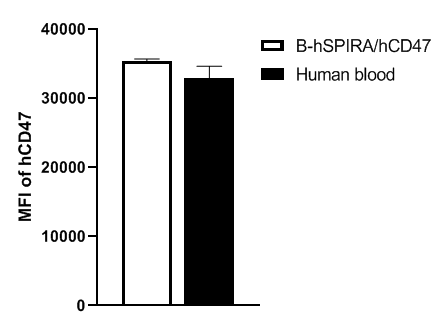
Analysis of hCD47 expression level on red cells in B-hSIRPA/hCD47 mice and human blood by flow cytometry. Red cells were collected from blood of B-hSIRPA/hCD47 mice and human (n=4). The results showed that there was no significant difference in the expression level of human CD47 between B-hSIRPA/hCD47 mice and human red blood cells.
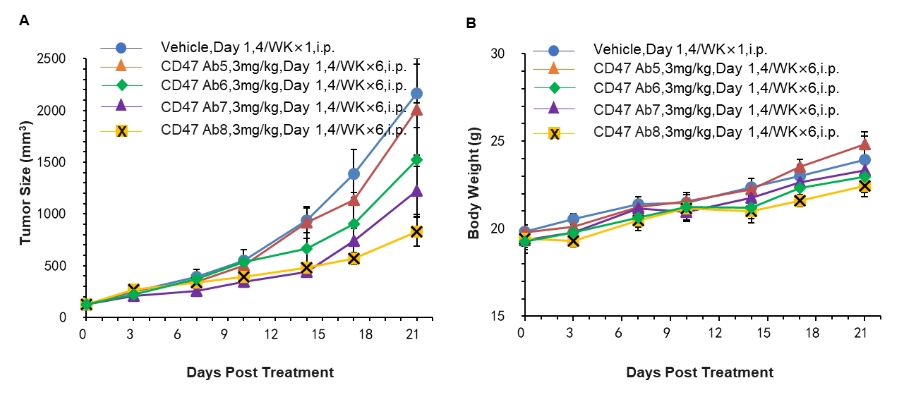
Antitumor activity of anti-human CD47 antibody Hu5F9 (in house) in B-hSIRPA/hCD47 mice. (A) anti-human CD47 antibody inhibited MC38-hCD47 tumor growth in B-hSIRPA/hCD47 mice. Murine colon cancer MC38-hCD47 cells were subcutaneously implanted into homozygous B-hSIRPA/hCD47 mice (female, 6-8 weeks old, n=5). Mice were grouped when tumor volume reached approximately 150 mm3, at which time they were treated with anti-human CD47 antibody with doses and schedules indicated in panel. (B) Body weight changes during treatment. As shown in panel A, anti-human CD47 antibody was efficacious in controlling tumor growth in B-hSIRPA/hCD47 mice, demonstrating that the B-hSIRPA/hCD47 mice provide a powerful preclinical model for in vivo evaluation of anti-human CD47 antibodies. Values are expressed as mean ± SEM.
